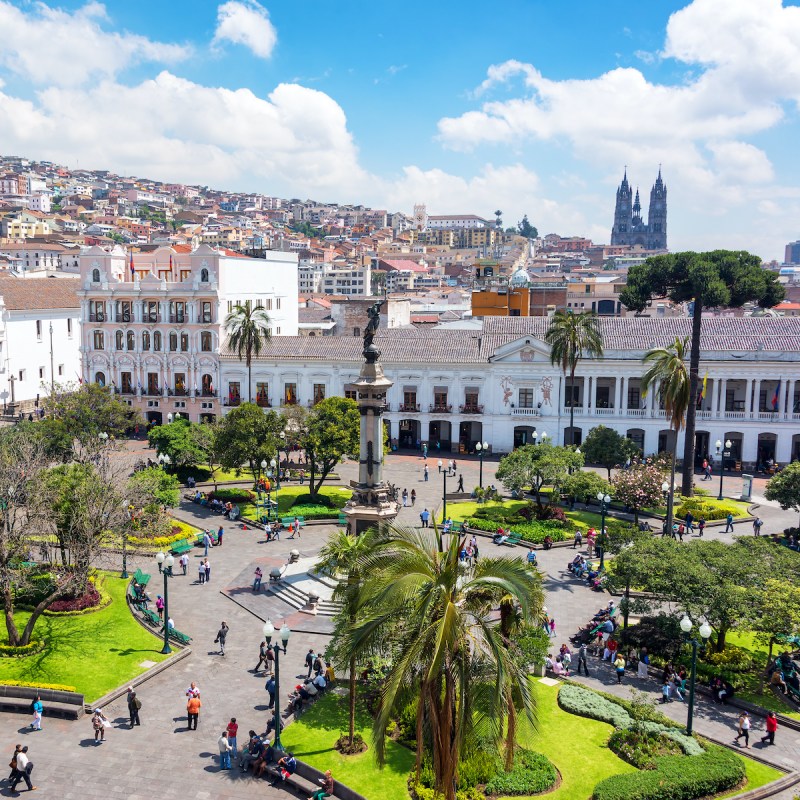
Formally San Francisco de Quito, the capital city of Ecuador sits high in the Andean mountains at an altitude of 9,350 feet. Living in east Texas at barely 100 feet above sea level, it took a few days for my small lungs to adjust.
Videos by TravelAwaits
At the tail end of a 2-week birdwatching trip in the mountains of northwestern Ecuador, my group decided to spend our last day touring this fascinating city. I had purchased a map at the Quito airport and the debate began of where, when, and how.
With over 2.6 million people and probably twice as many buildings, Quito is crammed into a valley with structures crawling 3 miles up to the mountaintop. One of the first UNESCO World Heritage Sites designated in 1977, the historic significance of the city is world-renowned.
Only a few corridors are available to steer slow-moving bicycles, fast-moving motorcycles, large red city buses, little yellow taxicabs, loaded delivery trucks, wobbly horse-drawn carts, and private cars to their destinations in the valley. Hence traffic is congested, hectic, slow, and sometimes downright chilling.
But don’t let this scare you away from seeing one of the most fascinating and historic cities in South America. Quito offers once-in-a-lifetime experiences. It did not take long to realize hiring a reliable guide and comfortable van for the day would be best, and our day turned out to be perfect.
At the first sign of a gray sky, as the sun slowly rose far below the top of the mountain behind the city, we headed to our first stop which was actually out of town, to a place that formed when one of the surrounding sleeping volcanos woke up.

1. Hike Down A Volcano-Made Crater
I watch in fascination as this bustling city of colorful homes and confusing graffiti rushes past the cozy van’s window. Northwest of the city center sits the Pululahua Crater Geobotanical Reserve, a massive crater created thousands of years ago by the Pululahua volcano.
Believed to be one of only a few craters in the world inhabited by humans, scores of brown and green checkered fields and farm buildings sprawl along the crater’s floor almost a mile down from the visitor center.
As I stood on the edge looking almost straight down contemplating the hike back up, two Andean women dressed in traditional clothing with filled-to-the-brim backpacks walk past. They aim for the narrow rock path that leads to the farms below, and I realize the only way to reach their farm on the crater floor is by foot.
Most of us decided that shopping instead of hiking was the best way to start the day and headed for a strip of thatched-roofed rustic buildings near the visitor center. Crammed full of handmade crafts sold by fair-trade Andean vendors, we learn that the famous Panama hat was originally made by workers and materials from Ecuador and shipped to Panama in the mid-18th century. Hence the name was given by Ecuadorians because of the hat’s destination.
The flamboyant artisan crafts ranged from baskets and clothing to musical instruments, pottery, and much more, all hand-crafted by indigenous people from the area.
I will always prize my soft alpaca wool poncho purchased from the family who made it.
Pro Tip: After a full day in Quito, it turned out that this was the best place to purchase quality gifts to take home. Shop accordingly!

2. Walk Along The Equator
Just a few miles from the Pululahua Crater sits the La Mitad del Mundo (The Center of the World). A towering stone monument designating the official GPS location of the equator poses perfectly for a selfie.
Here, you’ll find people from all nations straddling the equator’s line drawn on the concrete floor — or lying across, walking, or sitting on the line – all smiling in front of cameras.
Pro Tip: There is also an Equator Museum a few miles away from the actual location of the equator. While the museum is very interesting, if you want to visit the so-called Center of the World, be sure your guide takes you to the right place.

3. Pray In A Forever Unfinished Church
One of the most significant cathedrals in South America, the Basilica del Voto Nacional (The Basilica of the National Vow), has been under construction since 1887 and is still today technically “unfinished.” Every year a change is made or something added to the church. It is never finished due to local legend that declares when the Basilica is complete, the world will come to an end.
Be prepared for serious neck cramps from looking up at stunning stained-glass windows, impressive ceiling artwork, colorful floating saints, and nightmarish gargoyles.
Pro Tip: Be sure to save a little time to roam the courtyard to find an interesting cemetery where famous Ecuadorians are buried.

4. Have Lunch With The Virgin Of Quito
From the steps of the Basilica, I stared in awe at narrow streets dropping down into a valley of buildings and people, then snake back up the opposite mountain facing the church, where the famous Virgin of Quito statue stood gracefully on the top waving to us.
Our guide expertly navigated the steep crowded streets winding up to the El Panecillo hilltop, and soon, we were standing in front of the Virgin of El Panecillo statue — also known as the Virgin of Quito — looking up again.
This magnificent image of the Mother Mary ranks 58th among the tallest statues in the world, rising to 30 meters (just under 100 feet), plus 11 additional meters (another nearly 40 feet) if the base is included.
Made of 7,400 aluminum parts, the shining, bigger-than-life statue combined with 360-degree panoramic views of Quito make this site not only spiritual but also spectacular.
Pro Tip: Near the statue and clinging to the hillside is a rustic restaurant offering local cuisine with an amazing view.

5. Hang Out With An Andean
Quito boasts of having the largest, least altered, and best preserved historic center in the Americas. The foundation of the historic city is the Plaza de la Independencia (Independence Plaza) surrounded by picturesque and colorful 500-year-old buildings built during Spanish rule. Here, the Metropolitan Cathedral and the popular theater, the Carondelet Palace, are both show-stoppers.
The Plaza de la Independencia is known as the premier place for people watching, which is a favorite activity in Quito. A beloved public area during weekends, people of all ages and from all parts of Ecuador gather to drink coffee, sell their crafts, discuss politics, and watch the multi-colored tourists.
The highlights of the plaza are the indigenous Andean people selling their crafts while wearing the vibrant traditional clothing of their ethnic groups. Ecuador is home to one of the oldest civilizations in South America, dating back 10,000 years. Over 10 indigenous languages can be heard throughout the Ecuadorian Andes alone.
Pro Tip: If lunch at the El Panecillo is not possible, the Plaza de la Independencia has wonderful options. Don’t hesitate to try delicious fresh fruit and crunchy fried empanadas sold from small carts with large wheels and served with smiles.

6. Discover Gold
Near the edge of the Plaza de la Independencia is the Church of La Compania de Jesus — a fine example of baroque-style art. The main temple is carved entirely of volcanic stone. But what is really impressive is the ornate interior that is almost completely covered with sheets of gold!
Built in 1586 by the Jesuit Order, the church was visited by Pope John Paull II in 1985 and Pope Francis in 2015. This site has become an invaluable heritage site for Ecuador for its incredible artistic and financial value.
Pro Tip: There is a modest charge to enter, and you should expect a long line of people. But spending time in this remarkable building bathed in gold is well worth the effort.

7. Smell The Best Of Ecuador
Our last stop of the day — a busy, bustling farmers market — satisfied the gardeners and foodies in our group. Long tables crammed with rows of fruits and vegetables were almost a work of art. Friendly vendors showed us the difference between a banana and a plantain and explained that the potato originated in South America. There must have been a dozen different varieties of potatoes.
The bright colors of an enormous display of flowers in the neighboring room reminded me of the colorful clothing worn by the Andean women at the plaza. During the last few weeks, we’d found many beautiful flowers along our path to find birds, especially the 130 species of hummingbirds found in Ecuador.
Our guide explained that Ecuador is the world’s leading exporter of cut flowers. Over 4,000 species of orchids have been discovered in Ecuador, but the leading flower in demand for export is the rose. The sweet scent of hundreds of fresh-cut flowers in the farmers market surrounded me.
Pro Tip: Fresh food or flowers will be confiscated at customs when re-entering the United States. However, I found a variety of hand-crafted art pieces that included dried flowers in their designs, such as a wall-hanging mosaic of a toucan using dried natural reeds and seeds.
Know Before You Go
Ecuador uses the U.S. dollar as its currency. However, any bill over $20 will be hard to use at small local vendors. Keep a stack of small bills and coins in a separate bag for taxis, buses, and shopping. Occasionally my credit cards would not work in rural ATM machines for cash back.
Captivated by Ecuador? Don’t miss these 9 Amazing Experiences In Quito or our comprehensive guide to retiring in Ecuador.

